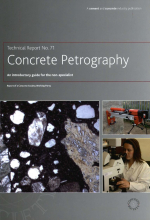Добрый день, Коллеги. Важное сообщение, просьба принять участие. Музей Ферсмана ищет помощь для реставрационных работ в помещении. Подробности по ссылке
Concrete Petrography. An introductory guide for the non-specialist / Прикладная петрография. Вводное руководство для неспециалистов
Petrography (from the Greek petra meaning rock and graphus meaning writing or a record) originated over 150 years ago as a technique employed primarily by geologists, who used microscopes to examine rock samples to identify their mineralogical and chemical characteristics. Petrographic techniques have since been applied to a wide range of materials used in construction including building stone, aggregate, soil, cement, concrete, mortar, brick, and bituminous mixtures. The polarising microscope has been used for the examination of cementitious materials since 1887. Almost one hundred years ago a series of six articles'1' in Concrete and Concrete Construction, the forerunner of today's CONCRETE, described the possibilities of using a microscope for examining concrete. In the last 40 years, petrography has become widely used for both research and commercial investigation of concrete structures. Petrographic examination is a laboratory procedure that is unique in that it relies highly on visual inspection of the samples. It requires specialist sample preparation and microscopical equipment and operators with appropriate qualifications and experience. Using the microscope the petrographer can determine the composition of concrete, assess its quality, and investigate the causes and extent of any deterioration. Photographs taken through the microscope (photomicrographs) record petrographic features of concrete samples. <...>




